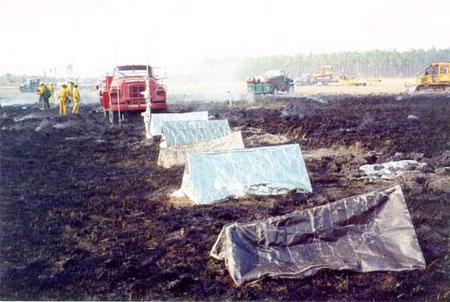
Surviving
Fire Entrapments
Test Results
Also read about engine entrapment incidents:
|
 |
Surviving
Fire Entrapments
Comparing Conditions Inside
Vehicles and Fire Shelters |
Test Results
Specific burn tests were conducted on three sites between February and
July 1996:
- Lake City, FL (February 1996)-in cured bunchgrass, and matted grass
and thatch (NFFL Model 3):
- Valencia, CA (June 1996)-in 2- to 3- foot (0.6- to 0.9-m) tall chamise
with a cured grass understory (NFFL Model 4):
- Beaverhead National Forest, MT (July 1996)-in lodgepole pine slash
(NFFL Model 12).
Florida Burn
At Lake City, FL, two surplus vehicles were selected for testing: the
first was a standard wildland engine; the second was a standard pickup
truck used for carrying a crew, with a slip-on pump and tank unit in the
back.
The first burn was conducted on February 27, 1996, on an open, grasscovered
field that had dry, cured bunchgrasses 30 to 36 inches (76 to 91 cm) tall,
with a 2- to 4-inch (5 to 10 cm) mat of cured grass and thatch on the
ground. The burn was in late afternoon with a 3- to 5-mile per hour wind.
It was over in less than 1 minute, and had neither the intensity nor the
duration to seriously test the survivability of the shelters or the engines
(Figure 13).

Figure 13-The Florida burn was not intense enough and did not burn for
long enough to seriously test survivability inside either the shelters
or the vehicles.
Despite the brief duration and low intensity of this burn, some meaningful
data were gathered:
- The peak air temperature was 650 °C in front of the engine and
950 °C in front of the pickup truck, as measured by the thermocouple
trees.
- In the grass fuel type, air temperatures decreased as the height above
ground level (AGL) increased.
- Air temperatures inside the engine cabs cooled more slowly than air
temperatures outside after the burnover.
- Maximum heat flux was 70 kW/m2, decreasing with the height above ground
level.
- Fire shelters subject to the burnover showed no visible signs of damage,
although the stainless steel prototype shelter had some discoloration.
Air temperatures inside the shelters were 20 to 40 °C lower at 1
inch (3 cm) AGL than at the thermocouple 12 inches (30 cm) AGL.
- Temperatures less than 3 feet (0.9 m) above the ground surface were
1000 °C, with a heat flux of 8 kW/m2.
- Personal protective equipment laid out in the fuels suffered varying
degrees of damage: the Military Nomex flight suit was badly damaged,
as was the FR cotton brush coat. The standard FS Nomex shirt and trousers
showed signs of the heat, but were not destroyed. They would have offered
some protection from serious burns (Figure 14).

Figure 14-The change
in color of the pants shows the effect of heat. Water bags inside the
fire shirt and upper pants served as a heat sink, keeping them from
becoming as hot as the pant legs.
A second burn was planned in a heavier palmetto-galberry fuel type (NFFL
Model 7). Heavy rains prevented us from conducting the burn as planned.
In summary, this burn served as a good "shakedown" for the
procedures and techniques used in future tests, but it was not long enough
or hot enough to develop meaningful data about the differences between
the protection offered by a fire shelter and an engine cab.
<<< continue
reading—Surviving Fire Entrapments, Los Angeles Burns >>>
|
